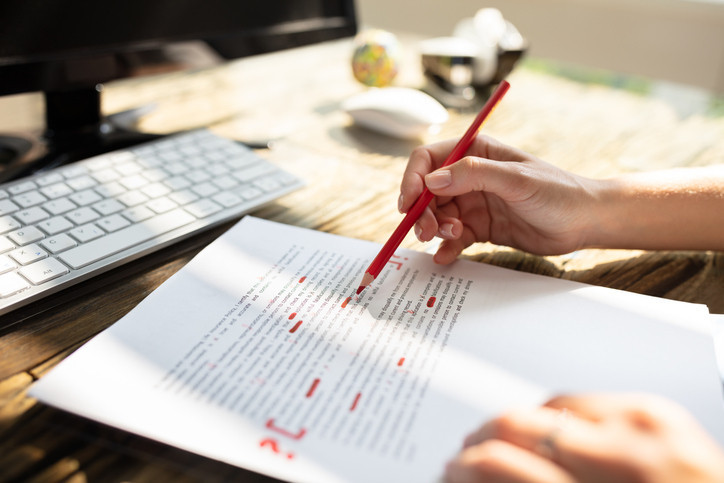A Marketers Guide to Self-Editing
The editing process is an important part of the content creation process, some may even say it is the most important part. Although it may be a chore to go back through your work to double and triple check for any mistakes, it can actually make or break the piece of content.
‘Content writer’ or ‘content creator’ are two titles that are thrown around a little bit nowadays. What we’re trying to say is the word content is not used sparingly these days. Content refers to any information, images or video which is included as part of a platform like a website, social media or blog. Content can come in many different forms, but in this article, we’re going to focus on long or short-form written content.
What should I check for when completing the self-editing process?
There are so many easy things you can be checking for, so start with the basics, then work up to the more complex edits that need to be made.
- Check for grammar and spelling errors: Nobody wants to be reading something and see that the author has mixed up ‘their’ and ‘there’ or has added another ‘c’ in necessary. The most basic edits you can make are the ones to your spelling and grammar.
- Check for missing words and awkward sentences: Sometimes you can get in the flow of writing, and your writing struggles to keep up with your brain, which could lead you to miss out words. It’s a mistake we can make in the moment. If you didn’t go back and read through your work, chances are you’d miss the error. While editing, also make sure to take note of your sentence structure. Is there a better way of phrasing something?
- Look for a passive voice and continuity: You want your piece of content to really come alive to the reader, and that won’t happen if you use a passive voice. If appropriate, incorporate your personal voice into the writing. Your readers will resonate with it more as it will feel like it wasn’t written by a robot.
Tools to use when editing
There are so many free editing tools available on the internet right now. The hardest part is deciding which ones work best for you. Here are three of our favourite editing tools.
Grammarly
You’ve probably seen their adverts before, but Grammarly is a website that goes further than the in-built spell check you have on your software of choice (for example, Google Docs or Microsoft Word). Grammarly checks spelling, grammar, punctuation, as well as sentence structure and word style. Even with the free customisations, Grammarly will work well as an editing tool.
Hemingway Editor
Hemingway Editor is slightly different, as it is a tool that shows you what grade level (or if you’re in the UK, year) a person needs to be at to read your work. It’s also software that highlights any sentences you may need to change in order to make your writing easier to read. If you’re purposely writing simplistically to appeal to a certain audience, then a lower grade level would be a good thing. However, if you’re drafting a piece of academic content, you’ll probably want it to appeal to a higher grade.
Ginger
Ginger is an interesting one as it’s an AI-powered writing assistant which can be integrated into your browser, it will even work on social media too! As you write, it will correct your mistakes and writing style. It will also offer synonyms or rephrase options to enhance your creativity when writing.
Copyscape
Copyscape is another great online editing tool as it is a plagiarism checker made specifically for people like you (and us), content creators and marketers. Systems like Grammarly will also run a check for plagiarism, but Copyscape is arguably the best plagiarism checking tool. For any writers, bloggers or content creators, Copyscape is the perfect website to help prevent any accidental plagiarism. We know you can get wrapped up in your writing, so Copyscape will just act as the middle man between a first draft and publication.
What does good self-feedback look like?
Feedback can come in lots of different forms. However, not all of it is necessarily helpful. When self-editing your piece of writing, you should be working with the piece in its entirety, rather than isolating your work into sections. Some writers prefer to just concentrate on their first draft and get words written onto a page. While others prefer to write a paragraph and then revisit it before moving on to the next. Whichever approach you choose to take, make sure it’s the one that works best for you.
For example, if you find you lose your flow when you stop to edit a paragraph, make a note of it and just continue writing. By looking at your writing from a wide perspective, you’ll be able to see what sections need rearranging and will be able to consider the audience who is reading your piece.

When should I pass the editing on to someone else?
Your piece of work won’t reach its full potential until it’s read by someone else. Getting another eye to look over your work will massively improve it, as they will pick up on things that you maybe missed the first time. After you finish writing your first draft, wait at least one night before diving into editing it. Once you feel like you’ve completed a full edit of your piece of work, then it’s time to part with your work and give it to someone else to check over. A tip for when you do get to this point is to ask your editors questions. Giving your editors guidance and not just throwing them in the deep end by saying ‘read this’ will result in a more successful piece of work. If an editor doesn’t know what the piece is about, who you’re writing to and what you want them to take away from the content, then they might not understand the full concept of your work.
Self-editing is critical and must come before someone else reads the content
Editing is the bridge between a first draft and a finished piece. Think of self-editing as the first step you can take on that bridge. In order to walk over the bridge, you must take the first step. Self-editing is critical, because if you can’t pick up on a mistake you’ve made, then how is someone else supposed to?

